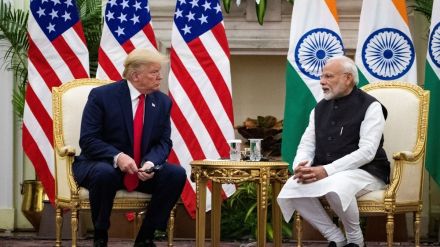It was unusual for Prime Minister Narendra Modi to lavish praise on an individual, not once but twice, in the space of four days, but he did. The object of the praise was President Donald J. Trump. The subject was the 20-point ‘Peace Plan’ that Mr Trump had proposed “to bring the war between Israel and Hamas to an end”.
On September 30, 2025, Mr Modi called it a “comprehensive plan to end the Gaza conflict. It provides a viable pathway to long-term and sustainable peace, security and development for the Palestinian and Israeli people, as also for the larger West Asian region”. Mr Modi also took the extraordinary step of issuing the statement in seven languages — Arabic, Chinese, English, French, Russian and Spanish, as well as Hebrew and, of course, Hindi. On October 4, Mr Modi said, “We welcome President Trump’s leadership as peace efforts in Gaza make decisive progress.”
As I write, Hamas and Israel have agreed to the first phase of the plan. Hamas will release the hostages and Israel will cease fire — it is not clear when, but shortly. Celebrations brought people to the streets in both Gaza and Israel. Hamas has not yet accepted several aspects of the plan, especially on ceding control to an external authority.
Ominous beginning
Naturally, questions have arisen on why Mr Modi showed extreme anxiety to praise and please Mr Trump when the latter has only heaped injury and humiliation on India since he assumed office on January 20, 2025.
In his first term as President (2017-2021), Mr Trump targeted India and other countries by imposing tariffs on steel (25 per cent) and aluminium (10 per cent), and terminated GSP benefits to India. In 2020, he suspended several categories of visas that were used by Indians, especially H-1B. Yet, at a rally in Houston, Texas on September 22, 2019, Mr Modi made the infamous declaration ‘Abki Baar, Trump Sarkar’.
In the nine months of his second term, Mr Trump has imposed the highest tariffs on India (and Brazil) virtually halting India’s exports to the United States of steel, aluminium, textiles, gems and jewellery, sea food, pharmaceuticals, footwear, furniture, cars and toys. He accused India of “funding the war against Ukraine” by buying Russian oil, and imposed an additional 25 per cent tariff on Indian goods. His close ally, Senator Lindsay Graham, told India that the U.S. will “tear up the hell out of you and we’re going to crush your economy” if India continued to buy Russian oil. Mr Trump called India the ‘Tariff King’ and his trade adviser Mr Peter Navarro said worse. Slamming India-Russia ties he called both “dead economies”. He also slapped a humongous fee of USD 100,000 on applications for H-1B visas and tightened the rules for issuing student and spouse visas. In February-May 2025, over a thousand Indians, allegedly illegal immigrants, were deported to India with handcuffs and leg chains in military aircraft.
Trump favours Pakistan
Despite Pahalgam and India opposing the largesse, in May-June 2025 Pakistan received billions of dollars of assistance from the IMF (USD 1 billion), ADB (USD 800 million) and World Bank (USD 40 billion) with crucial support from the United States. Mr Trump claimed, despite Indian denials, that he had mediated to bring the India-Pakistan war to an end, and continues to make the claim. The ultimate humiliation was when he hosted the Army Chief of Pakistan on June 18 to an unprecedented lunch at the White House. On September 25, Mr Trump held a joint meeting with the Prime Minister and the Army Chief where Pakistan’s “great leaders” — Mr Trump’s words — offered to supply critical rare earth minerals; sealed a trade deal with tariffs on Pakistani goods at 19 per cent; and invited the U.S. to build and operate a port on the Arabian Sea. Forgotten were 9/11, Osama bin Laden, Abbottabad, and the description of Pakistan as “a terrorist safe haven”. Pakistan seems to have learned the art of riding two horses (America and China) at the same time.
There is not one thing that the U.S. has done since January 2025 that can be described as friendly to India. India-U.S. relations have been on an escalator marked ‘Down’. And Mr Modi is desperately trying to walk up the down staircase.
Killing a dream
The intriguing question is why did the prime minister of India jump to praise Mr Trump using the opportunity of an Israel-backed ‘peace plan’ that leaves Palestinians in despair. Point 19 reads:
‘While Gaza re-development advances, and when the PA reform program is faithfully carried out, the conditions may finally be in place for a credible pathway to Palestinian self-determination and statehood’ (emphasis mine).
In my view, the war may stop finally, the hostages (or their remains) may be released shortly, and humanitarian aid may reach the hapless residents of Gaza, but Gaza itself will be a virtual colony under an ‘apolitical committee’ supervised by a ‘Board of Peace’ consisting of the likes of Mr Trump and Mr Blair. The Palestinian dream of statehood is virtually dead.
Apparently, for all the vain boasts, the prime minister has realized that India has few friends in the world and the Indian economy is not resilient enough to weather the storms raging around it. Flattery is no substitute for smart diplomacy and sound trade and investment policies.
